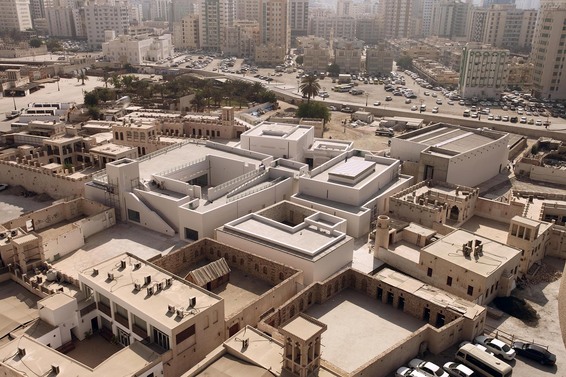
R
E
V N
E
X
T
Sharjah Biennial 13 To Expand Far Beyond the UAE
Sharjah Biennial 13 curator CHRISTINE TOHMÉ has announced events across five cities for the upcoming edition. Photo by Tarek Moukaddem. All images courtesy Sharjah Art Foundation, Sharjah.
The 2017 edition of the Sharjah Biennial will be underway soon in mid-October, with programs extending extending through January 2018. As part of a major overhaul from its past formats, Sharjah Biennial 13 (SB13) will not be taking place exclusively in Sharjah and its environs in the United Arab Emirates. Instead, the 15-month program, orchestrated by curator Christine Tohmé, will include displays of artworks, exhibitions and events in five cities throughout the last months of 2016 and in 2017, namely Dakar, Istanbul, Ramallah and Beirut, as well as in Sharjah itself.
The shake-up in the Sharjah Biennial’s traditional structure was announced today by the Sharjah Art Foundation, along with the theme and dates for the many programs—neatly illustrated in a schematic map by Cairo-based graphic designer Nancy Naser Aldeen. Tohmé has titled SB13 “Tamawuj” and offered three definitions for the Arabic word: “a rising and falling in waves”; “a flowing, swelling, surging, or fluctuation”; and “a wavy, undulating appearance, outline, or form.” According to the announcement, SB13 will “pose questions around, and propose answers to, the conditions for the possibility of an art world.”
The first program to begin this mid-October is the SB13 School, a yearlong educational program in Sharjah that will host programs for children and adults, specifically targeting what is described as “local infrastructures in the western, central and eastern regions of the Emirate of Sharjah [to] empower their various communities.” On the same day, SB13 will launch a digital platform that Tohmé is calling “chip-ship,” a web-based platform which is described as “a centralized digital storage space, housing various media, images, and texts, addressing the four keywords: water, earth, crops and culinary.” These four terms correspond individually to specific programs in one of the partner locations, overseen by Tohmé’s chosen “Interlocutors” in the four cities.
In early 2017, the first offsite project based around the keyword of “water” launches in Dakar (Senegal) on January 8, with artist Kader Attia serving as the SB13 interlocutor there. Two months later, the SB13 exhibition, “Act I,” opens in Sharjah on March 10 with more than 50 international artists, and will run through June 12. This is followed by programs in Istanbul in mid-May, where the interlocutor is curator Zeynep Öz and the keyword is “crops,” and then in Ramallah, in August, around the subject of the “earth,” with curator Lara Khalidi. Wrapping up the year, Ashkal Alwan is organizing “Act II,” about the keyword “culinary,” that will run in Beirut from mid-October 2017 until early January 2018.
Tohmé described the motivation for expanding the Sharjah Biennial’s tradition format thusly: “In a region currently being invested with larger institutions and lesser infrastructures, SB13 will cross from the ideal to the material. Vital interventions will stretch the idea of the biennial in order to traverse rooted contexts, harnessing the agility and fragility of present informal networks.”
Tohmé, the co-founder in 1993 and still-current director of the Lebanese Association for Plastic Arts, Ashkal Alwan, was named the SB13 curator one year ago, in late September 2015. The expansion of the Sharjah Biennial’s format for this edition is very much in line with two of her longstanding interests: one being education—she founded the Home Workspace Program, a one-year postgraduate artist-residency in Beirut in 2011—and the other in fostering regional cultural networks, which she has elaborated and strengthened through the seven editions of Home Works: A Forum on Cultural Practices, organized to date in Beirut under the aegis of Ashkal Alwan, in conjunction with numerous regional curators and partner organizations.
SB13’s expansion of the biennial format, both in time and space, has had precedents. Okwui Enwezor, for instance, worked with six curators and extended Documenta 11 over five “platforms” on four continents between March 2001 and September 2002. However, the revamped format of SB13 reflects a new set of priorities for today’s curators, who seem to be interested in using the institutional platform of the biennial to address gaps in local infrastructure and discourse. For instance, over the last year, under artistic director Maria Lind, Gwangju Biennale 2016 (GB16) has also been running informal art programs with the Gwangju-based artist collective Mite Ugro, and GB16’s curators have been organizing public talks and coordinated programs (dubbed the “Infra-School”) with universities in Seoul, Gwangju, New York and the artist-run RAT School of Art. Tohmé’s SB13 will also unfold during a year when Documenta 14 artistic director Adam Szymczyk has chosen Athens as an additional destination for its programming (already underway), and an exhibition in April 2017 to precede the 100-day-long festival that kicks off in Kassel, Germany, in June of that year.
The public and professional responses to these multi-city, multi-part programs will take time to accumulate, and it’s too early to know whether these additional components will become more permanent features of any of these organizations. But, at the moment, a vanguard of curators is pushing biennales away from being exclusively large-scale exhibitions (by way of comparison, a very traditional-sounding Venice Biennale, entitled “Viva Arte Viva,” is being organized by Christine Macel for May 2017) in directions that are more dynamic, discursive and locally rooted.





